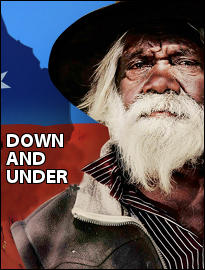The Dreamtime
The Dreamtime is titled in reference to an element of Aboriginal Australian mythology, a spiritual realm outside of traditional time and space. The film itself shares the stories of some of Australia's indigenous peoples and the ways in which white Australian culture has tried to better integrate the Aborigines into modern life while preserving the sanctity of tribal customs.
Many of the interview subjects share mythological stories about the spirits, or Mimis, and the roles they play in the land and nature. One such recurring figure is the Rainbow Serpent, representing the belief that "we are the land and the land is us." Through interviews with artists, curators, park rangers and Aboriginal tribe members, we learn that the Aboriginal Land Rights act of the 1960s allowed indigenous people rights to their ancestral lands, and saw the creation of nature reserves meant to preserve those lands.
A representative of Indigenous Tourism of Australia explains that their company aims to walk the line between sharing Aboriginal culture with tourists, and respecting tribal traditions for the local community. He is one of many interview subjects to emphasize the importance of storytelling and its role in passing cultural history down from one generation to the next.
Aboriginal cultures presented a strong draw to tourists, creating a new trend in the industry. In the late 1970s a profitable Aboriginal arts market came to prominence in the form of Mimi Aboriginal Arts & Crafts. The filmmakers take us to an area rich with strip malls and chain stores familiar to American viewers, but within these developed shopping areas Aboriginal craftspeople produce and sell their artwork and products. An owner of a Mimi handicraft store shows off some of her shop's wares, including paintings, rugs, jewelry, tools and clothing, and familiarizes viewers with some of the Australian mythology behind the shop's name.
Stepping away from colonialized culture and returning to nature by way of Kakadu National Park, viewers are privy to the production and use of didgeridoos, from the simple cutting of a slender, hallowed tree, to the skilled technique of playing the celebrated instrument.
Informative and inviting, The Dreamtime offers a personal look at Australia's efforts to balance the impact of colonization against a current desire to celebrate Aboriginal culture through the perspectives of both white and indigenous citizens.




Leave a comment / review